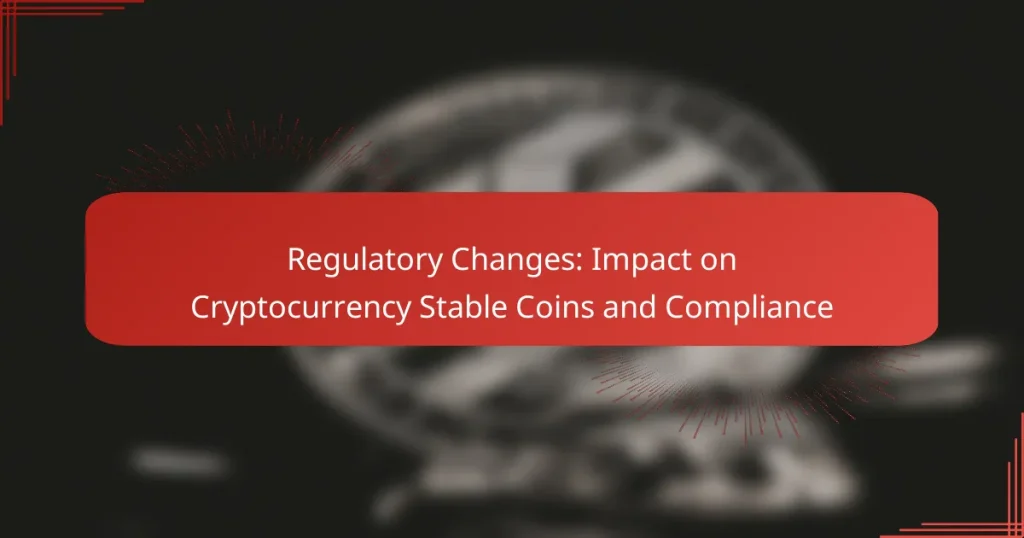Cryptocurrency stable coins are designed to maintain a stable value by [censured] to other assets, offering a reliable alternative in the volatile crypto market. The primary types include fiat-collateralized, crypto-collateralized, and algorithmic stable coins, each with unique mechanisms to ensure stability. Fiat-collateralized stable coins are backed by reserves of a specific fiat currency, while crypto-collateralized stable coins leverage other cryptocurrencies for their value. Understanding these types is essential for navigating the evolving landscape of digital currencies.
Stable Coin Types: Stability Metrics, Historical Performance and Trends
Decentralization in Stable Coins: Importance, Variations and Implications
Algorithmic Stable Coins: Benefits, Drawbacks and User Considerations
Market Demand for Stable Coins: Trends, Influencing Factors and Future Outlook
Fiat-Backed vs. Crypto-Backed Stable Coins: Key Differences and Investor Insights
Stable Coins: Use Cases, Selection Criteria and Key Differences
What are the most common types of cryptocurrency stable coins?
The most common types of cryptocurrency stable coins are designed to maintain a stable value by [censured] to other assets. These include fiat-collateralized, crypto-collateralized, and algorithmic stable coins, each with distinct mechanisms and considerations.
Fiat-collateralized stable coins
Fiat-collateralized stable coins are backed by traditional currencies like the US dollar or euro, ensuring that each stable coin is redeemable for a specific amount of fiat currency. For example, a stable coin like Tether (USDT) is pegged to the US dollar at a 1:1 ratio, meaning for every USDT issued, there is an equivalent dollar held in reserve.
These stable coins provide a reliable value but require trust in the issuing organization to maintain the reserves. Users should verify the transparency and regulatory compliance of these issuers to avoid potential risks.
Crypto-collateralized stable coins
Crypto-collateralized stable coins are backed by other cryptocurrencies rather than fiat currencies. They often use over-collateralization to manage volatility; for instance, a stable coin may require $150 worth of cryptocurrency to issue $100 worth of stable coins. This helps to absorb price fluctuations in the collateral asset.
Examples include DAI, which is pegged to the US dollar but backed by Ethereum and other cryptocurrencies. Users should be aware of the risks associated with the underlying assets, as significant price drops can lead to liquidation of collateral.
Algorithmic stable coins
Algorithmic stable coins use smart contracts and algorithms to control supply and demand, aiming to maintain a stable value without backing by any collateral. They adjust the supply of coins based on market conditions; for example, if the price rises above the target, new coins are minted to increase supply.
While they can be innovative, algorithmic stable coins are often more volatile and can face challenges in maintaining their peg during market fluctuations. Users should approach these with caution and understand the mechanisms in place to stabilize the value.
How do fiat-collateralized stable coins work?
Fiat-collateralized stable coins are digital currencies pegged to a specific fiat currency, such as the US dollar or the euro. They maintain their value by being backed by reserves of the fiat currency, ensuring that each stable coin can be redeemed for a corresponding amount of the fiat currency.
Backing by fiat currency
Fiat-collateralized stable coins are typically backed 1:1 by a fiat currency held in reserve. This means that for every stable coin issued, an equivalent amount of fiat currency is stored in a bank account or with a trusted custodian. This backing provides stability and trust, as users can exchange their stable coins for the underlying fiat currency at any time.
To ensure transparency and security, many issuers undergo regular audits to verify their reserves. Users should look for stable coins that provide proof of reserves and adhere to regulatory standards to mitigate risks associated with fraud or mismanagement.
Examples: Tether (USDT), USD Coin (USDC)
Tether (USDT) and USD Coin (USDC) are two of the most widely used fiat-collateralized stable coins. Tether is often used for trading on various cryptocurrency exchanges due to its liquidity and market presence. USD Coin, on the other hand, is known for its regulatory compliance and transparency, making it a popular choice for businesses and individuals alike.
Both stable coins aim to maintain a stable value relative to the US dollar, typically trading at or near $1. Users should consider the differences in transparency, regulatory adherence, and use cases when choosing between these options. Additionally, they should be aware of the potential risks involved, such as market volatility and regulatory changes affecting the stable coin ecosystem.
What are the benefits of crypto-collateralized stable coins?
Crypto-collateralized stable coins offer stability in value while leveraging the benefits of decentralized finance. They are backed by cryptocurrencies, which can provide transparency and security, making them an attractive option for users seeking to avoid the volatility of traditional cryptocurrencies.
Decentralization advantages
One of the primary advantages of crypto-collateralized stable coins is their decentralized nature. Unlike fiat-backed stable coins, which rely on a central authority, these stable coins operate on blockchain technology, ensuring that no single entity controls the assets. This reduces the risk of censorship and enhances user autonomy.
Moreover, decentralization allows for greater transparency in transactions. Users can verify the collateral backing the stable coin, fostering trust in the system. This transparency can also lead to more robust security measures, as the decentralized network is less susceptible to hacks or fraud compared to centralized systems.
Examples: DAI, sUSD
DAI is a prominent example of a crypto-collateralized stable coin, maintained by the MakerDAO protocol. It is pegged to the US dollar and is backed by various cryptocurrencies, primarily Ethereum. Users can generate DAI by locking up collateral in smart contracts, ensuring that the supply of DAI is always backed by sufficient assets.
Another example is sUSD, a stable coin issued by the Synthetix protocol. It is also pegged to the US dollar and allows users to trade synthetic assets on the Synthetix platform. Both DAI and sUSD demonstrate the effectiveness of crypto-collateralized stable coins in providing stability while promoting decentralized finance.
What are the risks associated with algorithmic stable coins?
Algorithmic stable coins face several risks that can lead to significant volatility and loss of value. Unlike collateralized stable coins, they rely on algorithms and smart contracts to maintain their peg, which can be susceptible to market fluctuations and investor behavior.
Market volatility impact
The primary risk for algorithmic stable coins is their sensitivity to market volatility. When the market experiences sharp declines, the mechanisms designed to stabilize the coin’s value may fail, leading to rapid devaluation. This can create a feedback loop where falling prices trigger further selling, exacerbating the situation.
Investors should be cautious, as algorithmic stable coins can experience price swings that are much more pronounced than traditional assets. Understanding the underlying algorithms and market conditions is crucial for assessing potential risks.
Examples: TerraUSD (UST)
TerraUSD (UST) is a notable example of an algorithmic stable coin that faced significant challenges. Initially designed to maintain a 1:1 peg to the US dollar, UST collapsed in 2022 when market conditions turned unfavorable, leading to a loss of confidence among investors.
This incident highlights the importance of scrutinizing the mechanisms behind algorithmic stable coins. Investors should evaluate the stability and reliability of the algorithms used, as well as the overall market sentiment, before engaging with such assets.
How to choose the right stable coin for investment?
Choosing the right stable coin for investment involves evaluating its underlying assets, regulatory compliance, and overall market stability. Consider factors like collateral type and adherence to regulations to ensure a secure investment.
Consideration of collateral type
The collateral type backing a stable coin significantly impacts its stability and risk profile. Common types include fiat-collateralized, crypto-collateralized, and algorithmic stable coins. For instance, fiat-collateralized stable coins are typically pegged to a currency like the US dollar, offering more predictability.
When assessing collateral, consider the liquidity and transparency of the assets involved. A stable coin backed by easily liquidated assets tends to be less volatile. Always check if the issuer provides regular audits to confirm the collateral’s existence and value.
Regulatory compliance factors
Regulatory compliance is crucial when selecting a stable coin, as it can affect its legality and acceptance in various jurisdictions. Coins that adhere to local regulations are generally safer investments, as they are less likely to face legal challenges. For example, stable coins that comply with Anti-Money Laundering (AML) and Know Your Customer (KYC) regulations are often viewed more favorably.
Stay informed about the regulatory landscape in your country, as it can change rapidly. Investing in stable coins that are compliant with regulations in your region can help mitigate risks associated with sudden regulatory crackdowns or changes in policy.
What are the use cases for stable coins in the US?
Stable coins serve various practical purposes in the US, primarily facilitating transactions that require price stability. They are increasingly used for remittances, decentralized finance applications, and as a means of transferring value without the volatility associated with traditional cryptocurrencies.
Remittances and cross-border payments
Stable coins simplify remittances and cross-border payments by providing a stable value that reduces the risks associated with currency fluctuations. Users can send funds quickly and at lower fees compared to traditional banking methods, which often involve high charges and lengthy processing times.
For example, using stable coins like USDC or Tether (USDT), individuals can transfer money internationally in minutes, bypassing the need for intermediaries. This can save users significant amounts, especially when sending larger sums.
Decentralized finance (DeFi) applications
In the DeFi space, stable coins are essential for creating a stable medium of exchange, allowing users to lend, borrow, and trade without the volatility of other cryptocurrencies. They provide liquidity in various DeFi protocols, enabling users to earn interest or yield on their holdings.
Stable coins like DAI and USDC are commonly used in lending platforms, where users can deposit these assets to earn interest rates that often exceed traditional savings accounts. However, users should be aware of the risks involved, such as smart contract vulnerabilities and market liquidity issues.
How do stable coins impact cryptocurrency markets?
Stable coins significantly influence cryptocurrency markets by providing a reliable medium of exchange and a hedge against volatility. They help traders and investors maintain liquidity while minimizing the risks associated with price fluctuations common in traditional cryptocurrencies.
Liquidity provision
Stable coins enhance liquidity in cryptocurrency markets by allowing users to quickly convert their assets without the need for fiat currency. This ease of conversion facilitates smoother trading experiences, as traders can enter and exit positions rapidly, often within seconds.
For example, during periods of high market volatility, traders can convert their cryptocurrencies to stable coins to preserve value, then switch back when conditions stabilize. This ability to maintain liquidity is crucial for both individual investors and larger institutional players.
Price stabilization mechanisms
Price stabilization mechanisms are essential features of stable coins that help maintain their value against fiat currencies. These mechanisms can include collateralization, algorithmic adjustments, or a combination of both to ensure that the stable coin’s price remains pegged to a specific asset, such as the US dollar.
For instance, collateralized stable coins are backed by reserves of fiat currency or other assets, while algorithmic stable coins use smart contracts to automatically adjust supply based on market demand. Understanding these mechanisms is vital for users looking to leverage stable coins effectively in their trading strategies.






